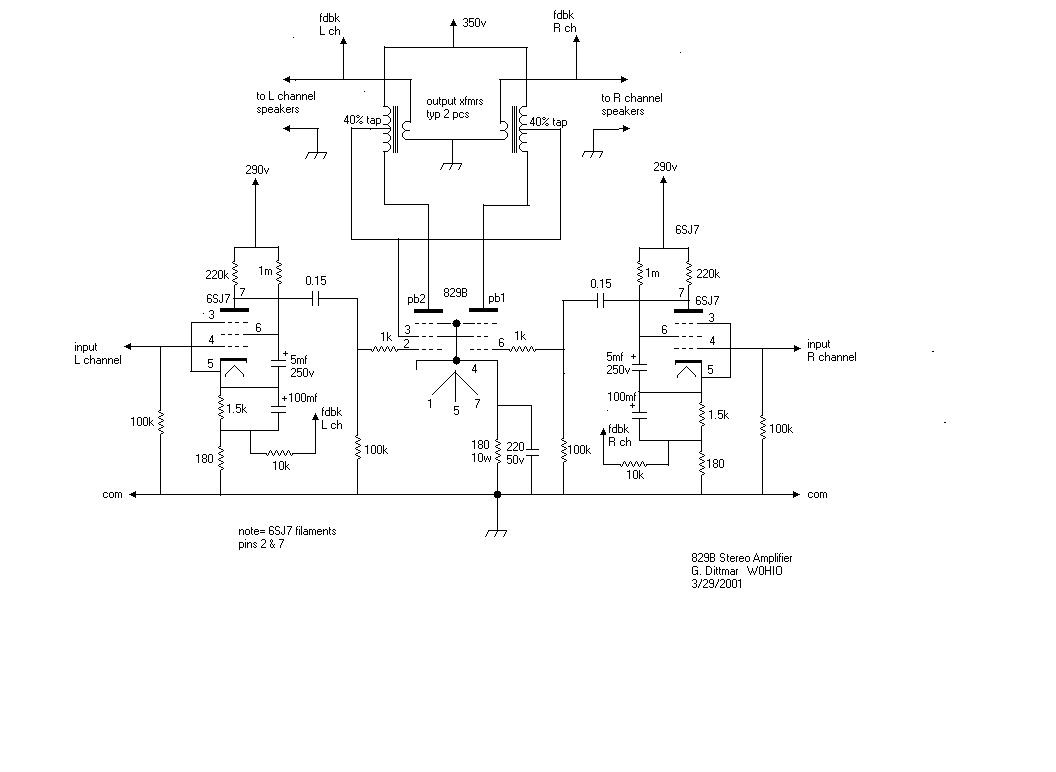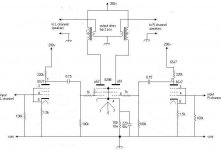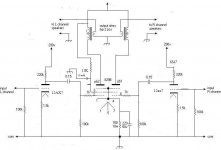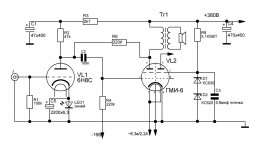Hi I am building a amp based on these designs

Me and a friend of mine changed it to the attached image on this post. I am looking for sugestions. This is also my first tube amp build. What changes would you make if you where to build it yourself? I would like to hear any sugestions.
Thanks,
Silverchris
PS. Please excuse the lack of credit on the second image. I lost it in my resizing. It s just a edited version of the original.

Me and a friend of mine changed it to the attached image on this post. I am looking for sugestions. This is also my first tube amp build. What changes would you make if you where to build it yourself? I would like to hear any sugestions.
Thanks,
Silverchris
PS. Please excuse the lack of credit on the second image. I lost it in my resizing. It s just a edited version of the original.
Attachments
You were right to abandon the first one - UL taps won't work with 829 with the shared screen grid. And a triode driver is simpler...
A couple of problems... the first stage has too high a load resistor to drive the 100K grid resistors - for AC purposes, it's a 3 : 1 step-down voltage divider. If you can use a higher grid resistor, that will help a lot. I know the 829 datasheet says not to use over 100K, but it's rated for fixed bias (which requires a lower resistance), not cathode bias. 100K load on 12AX7 and 220K grid resistor will give more gain. Larger coupling caps would be good too, if your output transformers have good bass response. Hammond 125 series don't, but are at least reasonably priced...
Pentodes should use some negative feedback to lower the output impedance - this is usually a resistor from speaker output to cathode of driver.
A couple of problems... the first stage has too high a load resistor to drive the 100K grid resistors - for AC purposes, it's a 3 : 1 step-down voltage divider. If you can use a higher grid resistor, that will help a lot. I know the 829 datasheet says not to use over 100K, but it's rated for fixed bias (which requires a lower resistance), not cathode bias. 100K load on 12AX7 and 220K grid resistor will give more gain. Larger coupling caps would be good too, if your output transformers have good bass response. Hammond 125 series don't, but are at least reasonably priced...
Pentodes should use some negative feedback to lower the output impedance - this is usually a resistor from speaker output to cathode of driver.
I’ve been tempted by the 829 since it looks pretty neat, and I happen to have several of them with sockets lying around. But I’ve been put off by the low screen grid voltage rating of 225V and the fact that both screen grids are tied together with a small internal bypass cap to the cathode. This eliminates UL and triode modes. So you’re stuck with pentode mode, and as Tom said, that means high output Z without feedback. I would suggest a more robust driver tube too. Maybe the 829 is not the best tube for your first tube project…
Because of the common screen grid connection, I think you're better off paralleling both sections and triode-connecting (one tube per channel) the 829B.
In triode mode you can run the screen considerably higher than the ratings, based on my experiance and that of several others who've done it. Look at the 807 datasheet - you'll notice triode-mode voltage ratings are 400V, higher than the screen voltage rating of 300V. The 829B is very similar to two 807's in one envelope...
300V is certainly a safe plate voltage in triode mode. You can probably go even higher.
http://www.pmillett.com/829b_amplifier.htm
I've also tried push-pull pentode mode using the two sections of one tube. Here the screen voltage limit is more of an issue, so you either have to run low B+ or a lower, regulated screen voltage.
As was mentioned the Zo and distortion is quite high in pentode mode without any NFB.
I actually had better luck with the 829's little brother the 832 in push-pull pentode-mode operation. If I remember right with a plate and screen voltage of 250V, it had less distortion than the 829B, and got ~5 watts out.
Pete
In triode mode you can run the screen considerably higher than the ratings, based on my experiance and that of several others who've done it. Look at the 807 datasheet - you'll notice triode-mode voltage ratings are 400V, higher than the screen voltage rating of 300V. The 829B is very similar to two 807's in one envelope...
300V is certainly a safe plate voltage in triode mode. You can probably go even higher.
http://www.pmillett.com/829b_amplifier.htm
I've also tried push-pull pentode mode using the two sections of one tube. Here the screen voltage limit is more of an issue, so you either have to run low B+ or a lower, regulated screen voltage.
As was mentioned the Zo and distortion is quite high in pentode mode without any NFB.
I actually had better luck with the 829's little brother the 832 in push-pull pentode-mode operation. If I remember right with a plate and screen voltage of 250V, it had less distortion than the 829B, and got ~5 watts out.
Pete
Well My power tranny is a 400V one. I have yet to pick out the output transformers I am trying to find decenet ones for a set under 100$ MY friend guesses that you might be able to make 20 watts a channel from a setup like this. I will look into and make changes to the schematic and post it later on tonight.
Thanks,
Silverchris
PS. I saw your amp on google Pete and it looks really nice. I am gonna build it with a single tube for now and maybe later on switch to two tubes.
Thanks,
Silverchris
PS. I saw your amp on google Pete and it looks really nice. I am gonna build it with a single tube for now and maybe later on switch to two tubes.
I'm in love with the flying-saucer weirdness of the 829B/3E29 as well, and have been picking them up here and there. One nice feature is the heavy glass envelope. Anyway, I was thinking of doing a partial feedback RH-style amp with both sections of the tube paralleled in tetrode mode, using a pentode or cascoded JFET front end. This gets around screen voltage and output impedance quibbles and might yield respectable output power. This is where I might use my One Electron UBT-3 beasts.
I agree, it is a nice looking tube. But, come on man, why use a dual tetrode and run it in SE?
Partial feedback in SE tends to have poor PSRR anyways (in most, but not all configs).
Partial feedback push-pull will have good PSRR and takes advantage of having a dual tetrode envelope
Partial feedback in SE tends to have poor PSRR anyways (in most, but not all configs).
Partial feedback push-pull will have good PSRR and takes advantage of having a dual tetrode envelope
With regard to the last post - I seriously doubtful about the "verybestness" of Lynx's overkill design. You must know the russian saying "what is too much that is not healthy".
If anyone is still interested about the 829b - here is some schematic (sorry - it's drawn in russian, but i would comment it), aimed to build a truly two-bulb amp. The driver stage uses a 6H8C/6SN7 biased with a blue led. The output stage uses a single GMI-6 (kinda russian pulse-mod of 829B) for both channels, connected in pentode mode, with anode feedback (small amount) and stabilized at 250 volts 2nd grid (that is common). Strictly fixed bias (16v), not even a small cathode resistance. The OT is for 5K primary resistance. The amp sounds really amazing, very open and natural, all those SE triode lovers (that's what I have been )- forget your triodes, they're garbage
)- forget your triodes, they're garbage 
It is WORTH to try anyway once somebody's around a hard decision. Feedbacks are welcome.
If anyone is still interested about the 829b - here is some schematic (sorry - it's drawn in russian, but i would comment it), aimed to build a truly two-bulb amp. The driver stage uses a 6H8C/6SN7 biased with a blue led. The output stage uses a single GMI-6 (kinda russian pulse-mod of 829B) for both channels, connected in pentode mode, with anode feedback (small amount) and stabilized at 250 volts 2nd grid (that is common). Strictly fixed bias (16v), not even a small cathode resistance. The OT is for 5K primary resistance. The amp sounds really amazing, very open and natural, all those SE triode lovers (that's what I have been
It is WORTH to try anyway once somebody's around a hard decision. Feedbacks are welcome.
Attachments
Where do you get those diodes???
With regard to the last post - I seriously doubtful about the "verybestness" of Lynx's overkill design. You must know the russian saying "what is too much that is not healthy".
If anyone is still interested about the 829b - here is some schematic (sorry - it's drawn in russian, but i would comment it), aimed to build a truly two-bulb amp. The driver stage uses a 6H8C/6SN7 biased with a blue led. The output stage uses a single GMI-6 (kinda russian pulse-mod of 829B) for both channels, connected in pentode mode, with anode feedback (small amount) and stabilized at 250 volts 2nd grid (that is common). Strictly fixed bias (16v), not even a small cathode resistance. The OT is for 5K primary resistance. The amp sounds really amazing, very open and natural, all those SE triode lovers (that's what I have been)- forget your triodes, they're garbage
It is WORTH to try anyway once somebody's around a hard decision. Feedbacks are welcome.
829B
"Maybe the 829 is not the best tube for your first tube project… " The best way to use 829B and other tubes with common screen grid is to parallel electrodes of both halves, an use a couple of tubes into your PP instead of only one. This would definitely solve your problems with UL PP.
"Maybe the 829 is not the best tube for your first tube project… " The best way to use 829B and other tubes with common screen grid is to parallel electrodes of both halves, an use a couple of tubes into your PP instead of only one. This would definitely solve your problems with UL PP.
- Status
- This old topic is closed. If you want to reopen this topic, contact a moderator using the "Report Post" button.
- Home
- Amplifiers
- Tubes / Valves
- 829B Based Amp


